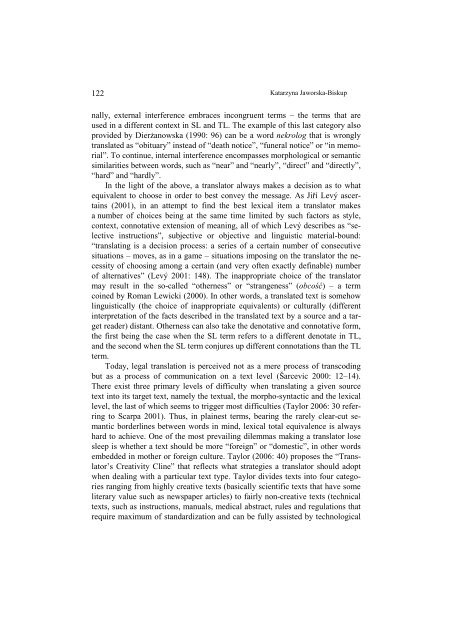s - Wyższa SzkoÅa Filologiczna we WrocÅawiu
s - Wyższa SzkoÅa Filologiczna we WrocÅawiu
s - Wyższa SzkoÅa Filologiczna we WrocÅawiu
Create successful ePaper yourself
Turn your PDF publications into a flip-book with our unique Google optimized e-Paper software.
122<br />
Katarzyna Jaworska-Biskup<br />
nally, external interference embraces incongruent terms – the terms that are<br />
used in a different context in SL and TL. The example of this last category also<br />
provided by Dierżanowska (1990: 96) can be a word nekrolog that is wrongly<br />
translated as “obituary” instead of “death notice”, “funeral notice” or “in memorial”.<br />
To continue, internal interference encompasses morphological or semantic<br />
similarities bet<strong>we</strong>en words, such as “near” and “nearly”, “direct” and “directly”,<br />
“hard” and “hardly”.<br />
In the light of the above, a translator always makes a decision as to what<br />
equivalent to choose in order to best convey the message. As Jiří Levý ascertains<br />
(2001), in an attempt to find the best lexical item a translator makes<br />
a number of choices being at the same time limited by such factors as style,<br />
context, connotative extension of meaning, all of which Levý describes as “selective<br />
instructions”, subjective or objective and linguistic material-bound:<br />
“translating is a decision process: a series of a certain number of consecutive<br />
situations – moves, as in a game – situations imposing on the translator the necessity<br />
of choosing among a certain (and very often exactly definable) number<br />
of alternatives” (Levý 2001: 148). The inappropriate choice of the translator<br />
may result in the so-called “otherness” or “strangeness” (obcość) – a term<br />
coined by Roman Lewicki (2000). In other words, a translated text is somehow<br />
linguistically (the choice of inappropriate equivalents) or culturally (different<br />
interpretation of the facts described in the translated text by a source and a target<br />
reader) distant. Otherness can also take the denotative and connotative form,<br />
the first being the case when the SL term refers to a different denotate in TL,<br />
and the second when the SL term conjures up different connotations than the TL<br />
term.<br />
Today, legal translation is perceived not as a mere process of transcoding<br />
but as a process of communication on a text level (Šarcevic 2000: 12–14).<br />
There exist three primary levels of difficulty when translating a given source<br />
text into its target text, namely the textual, the morpho-syntactic and the lexical<br />
level, the last of which seems to trigger most difficulties (Taylor 2006: 30 referring<br />
to Scarpa 2001). Thus, in plainest terms, bearing the rarely clear-cut semantic<br />
borderlines bet<strong>we</strong>en words in mind, lexical total equivalence is always<br />
hard to achieve. One of the most prevailing dilemmas making a translator lose<br />
sleep is whether a text should be more “foreign” or “domestic”, in other words<br />
embedded in mother or foreign culture. Taylor (2006: 40) proposes the “Translator’s<br />
Creativity Cline” that reflects what strategies a translator should adopt<br />
when dealing with a particular text type. Taylor divides texts into four categories<br />
ranging from highly creative texts (basically scientific texts that have some<br />
literary value such as newspaper articles) to fairly non-creative texts (technical<br />
texts, such as instructions, manuals, medical abstract, rules and regulations that<br />
require maximum of standardization and can be fully assisted by technological
















